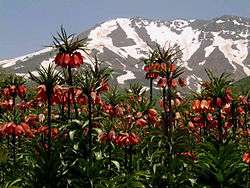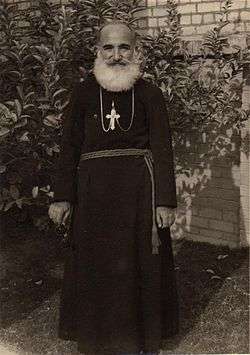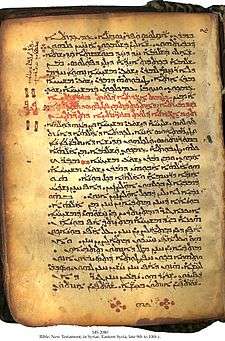Nochiya tribe
The Nochiya (Syriac: ܡܠܬ ܕܢܒܼܟ̰ܝܼܐ Millet D'Nochiya) is an Assyrian Christian tribe that was based in and around the district of Şemdinli,(or Jilu) in the province of Hakkari, Turkey. They are called Nochiya Assyrians, or (Syriac: ܢܘܿܟܝܼܝܐ Nochiyaye) and were also known as "the Metropolitan's Tribe" ("Millet D'Matran"). The Nochiya tribe is also referred to as the "Royal Tribe" because they are related to the ancient monarchs of Assyria. There an estimated 20,000 Assyrians who trace their ancestry to the tribe, dispersed throughout the world.[1]
| Part of a series on the |
| Nochiya Tribe |
|---|
| Est. 1663 A.D. |
People
The Assyrians of the Nochiya Region were simple farmers who owned cattle and grew food. They were known particularly for their fine tobacco, which was their main source of income along with herding sheep. Prayer and fasting were strictly observed in the villages of the Nochiya Assyrians. An Englishman visiting the Nochiya Region in the late 19th century noted that "there is perhaps no Assyrian district where simple piety and loyal devotion to the church of their fathers is more beautifully seen than in Nochiya".[2] Nochiyaye were and are still today most famous for their Eastern Rite faith and for being the guardians of the Assyrian Church of the East's canon laws, which they have faithfully preserved.[3]
Collectively, the ten clan-districts of the Nochiya Region contained some 65 villages that eventually became known as the Nochiya Tribe in 1663, with the appointment of the first Metropolitan of Şemdinli from the Matran family of the Gida House. However, The Ottoman Empire did not integrate the Nochiyaye as an official tribe within their "millet" social structure; nonetheless, they were recognized as an independent tribe by their Assyrian and Kurdish neighbors.[1]
Clothing
The famous felt cap worn by the Nochiyaye is a white conical cap made of wool-felt material, similar to that worn by the ancient Assyrian kings and Bishops, known as a "Shashta," hence the tribal nickname B'Shashtu.[1] The Shashta can be worn either with or without a turban, known as a "Shashikta."

Second, the cummerbund (Kharkhasa) tied around the waist is knotted, not looped.
Third, their clothes, although similar to other Assyrian and Kurdish tribes, are not patterned or striped but made of plain choice mohair wool.
The men's outfit consists of wide straight-legged trousers, a buttoned shirt, a jacket tucked into the baggy trousers, and a short pocketless waistcoat (Karika), usually white in color. They also wore a cummerbund to tie everything together around the waist and finally a "Shashta Cap" with an optional red turban.
Language
| Syriac alphabet (200 BCE–present) |
| ܐ ܒ ܓ ܕ ܗ ܘ |
| ܙ ܚ ܛ ܝ ܟܟ ܠ |
| ܡܡ ܢܢ ܣ ܥ ܦ |
| ܨ ܩ ܪ ܫ ܬ |
All Assyrian tribes speak the same language, Northeastern Neo-Aramaic, but differ in their dialects. The Nochiya tribe all speak with the same dialects, from Targawar in the north to Rawandiz in the south. It is practically impossible to differentiate between their Aramaic dialects.[1]
This is one of the most bonding factors in Assyrian tribes and it's interesting that the tribes adjacent to the Nochiyaye; Urmijnaye to the east, Gawarnaye to the north, Jilwaye to the west and Barwarnayeh to the southwest, all have completely different accents, to the point that some are almost unintelligible to the Nochiyaye.[1]
Society
The Nochiya tribe was not a "tribal confederation," but was based on the "bond of kinship" (tukhma). This point is important and what it means is that the ten clans are not just unified by leadership or geographical factors alone but primarily by blood and so, cannot be separated; they are shackled by the "bond of kinship," which defines their tribal affinity to outsiders.[1]
To further illustrate this point, the Rawandiz clan in the late 19th century changed both religious and leadership loyalty to the Chaldean faith but did not change their tribal identity. In fact, they still proudly identify themselves as "Catholic Nochiyaye".[1]
Kinship is an essential ingredient and the basis of any tribe. By contrast, some European tribes are only paternally related; however, Assyrian tribes are both paternal and maternal. The Nochiyaye are mostly paternal descendants of the Matran family of the Gida House; the rest are mostly related maternally.[1]
Leadership
An Assyrian tribe must have both religious and civil leaders to qualify as a tribe. This principle is called Gooraneh.
In the case of Nochiyaye it was the Metropolitan (Matran) of Shamizdin who was the religious chief and his brother, the civil chief, presided over the local lords (Maliks) of the Nochiya Region, such as Malik Tammu of Sararu, Malik Breemu of Badtemu, Malik Diryawish of Ambeh and Malik Samu of Baigardeh.
The Matran controlled the religious figures such as Mar Dinkha of Tees, Mar Youkhanan of Dariyan, and others, such as the archdeacons and priests within the tribe. He was primarily the Archbishop of the Assyrian Church of the East and was second in command only to the Patriarch, Mar Eshai Shimun XXIII.[1]
Geography

The Nochiya Tribes territory is unique in that it goes through three different countries: Turkey, Iran, and Iraq. The reason for this is because the Nochiya Tribes presence in the region predates these international borders, and because they were not consulted or considered when these international borders were drawn through their lands, similar to how the United States often drew state borders through Native American tribal territory. The Turkey-Iran border was created in 1515 after the Battle of Chaldiran split the Targawar, Bagzadeh and Margawar Clans away from the central Şemdinli district in Turkey, with the Nochiyaye lands within the Zagros mountain range in the eastern part of their territory becoming part of Iran literally overnight. The Turkey-Iraq border was created in 1926, with the signing of the Sykes-Picot Agreement, and cut away the Bradost, Rawanduz, and Sherwan Clans from the Shamizdin district in Turkey. However, at this point, no Nochiyaye even live within the heart of their territory in Shamizdin anymore.
Districts
The Nochiya Region is an area which consists of provinces, districts and sub-districts. The Nochiya Region lies in three different countries: western Iran, northeastern Iraq and southeastern Turkey, with Its de facto capital based in Mar Ishu,(modern day Karakilise, Şemdinli) as that is where its Metropolitan bishop resided and his cathedral was located. The districts that make up parts of the Nochiya Region are Şemdinli in Turkey, Soran District in Iraq, and the Silvaneh District in Iran.
Rustaqa was the central sub-district of the Nochiya Region. To the north of Dağ İçinde, in the district of Şemdinli, Turkey, were the clan-districts of Khumara and Dairaneh; to the east, in the district of Urmia, Persia, were the sub-districts of Bagzadeh, Margawar and Targawar. To the south, in what is now Arbil, Iraq, were the sub-districts of Gargan, Bradost, Sherwan and Rawandiz.
To this day, the Nochiyayeh people still speak, read, and write Leshana Ateeka (Aramaic). Although Nochiyayeh may no longer have a region (Except perhaps in Iraqi Kurdistan shared with the Kurds), they live in close communities with each other and are still very active members of their traditional Eastern Rite church community.
Religion
There were at least six monasteries and more than 40 churches within the Nochiya Region. The Nochiyaye were best known for their adherence to the Nestorian faith; because of this, religious customs such as Lent and prayer were strictly observed. The Mar Ishu Monastery in the village of Mar Ishu was a theological school for priests and was run by the Metropolitans of Shamizdin, who would not tolerate any changes to the church's canon laws.[2]

An Englishman visiting the Nochiya Region in the late 19th century noted that "there is perhaps no Assyrian district where simple piety and loyal devotion to the church of their fathers is more beautifully seen than Nochiya". Nochiyaye were and are still today most famous for their Nestorian faith and for being the guardians of the Assyrian Church of the East's canon laws, which they have faithfully preserved.[2]
There were other important religious figures in the tribe, including two bishops, four archdeacons, twelve priests, and a large number of deacons distributed among the clans. To this day, the majority of the priests and deacons within the Assyrian Church belong to the Nochiya tribe, including the Patriarch Mar Dinkha IV.[3]
Mar Iskhaq Khnanisho XI
Mar Iskhaq Khnanisho was the spiritual leader of the Shamizdin Assyrians and Metropolitan of the Assyrian Church of the East. Previously, he was styled as the Metropolitan of Rustaqa. His diocese in 1914 grew to include Shamizdin, Targawar, and Margawar. In his diocese were the bishops Mar Dinkha in the village of Tis, an ancestor of the present patriarch of the Assyrian Church of the East, Mar Dinkha IV; bishop Mar Youkhana of the village of Tulaki in Targawar, and after 1914, his own nephew, Mar Yosip Khnanisho X, who was ordained a bishop on the eve of World War I in Qochanis by Patriarch Mar Benyamin Shimon XXI.
Saint Mar Yosip Khnanisho XII
The 12th and the last of the metropolitans the Matran family donated to the church was Mar Yosip Khnanisho, who died on July 3, 1977 in Baghdad, Iraq. At an early age, he was aware for the sublime position he was dedicated, thus he had learned by heart the complete Eucharistic rites, performed in the church by a deacon or priest. He was tutored adequately by a learned scholar, Rev. Rehana, his father's uncle, who was well versed in the Aramaic, Russian and Turkish languages and an authority in Eastern theology. Rev. Rehana was the head of the Seminary in Mar Ishu Monastery and he taught classes to a number of students studying for the priesthood. From this seminary many graduated to become bishops and priests in various dioceses and parishes.

At age twelve, Mar Yosip was ordained a deacon. By 1912 Mar Yosip had already acquired a thorough knowledge of theology therefore he was found to be well suited to be ordained a priest. In the year 1914, at the beginning of World War I, he was sent as a delegate, representing the Metropolitan Mar Iskhaq Khnanisho, to participate in a most important meeting called by His Holiness Mar Benyamin Shimon XXI, the Catholicos Patriarch at the patriarchal cell in Qudchanis, Turkey, to discuss the effects of the World War on the Church and the nation and prepare for the changes that were expected to take place. While there he was consecrated a bishop on August 10, 1914, by His Holiness and was appointed as assistant to the patriarch.[4]
He remained in Qudchanis until 1916 when the Assyrians had to leave their homeland and possessions in consequence of the Great War. After the treacherous assassination of the Patriarch Mar Benyamin Shimon XXI in 1918, Mar Yosip assumed to a great extent, the leadership of the nation, until the Assyrians arrived in the refugee camps, set up by the Red Cross and League of Nations, at Baqubah, Iraq in 1918. In December 1918 he was elevated to the rank of Metropolitan in Baghdad by Patriarch Mar Paulos Shimon XX.[4]
When Mar Eshai Shimun XXIII, the Catholicos Patriarch, was exiled in 1933 by the monarchial regime of Iraq, Mar Yosip Khnanisho was entrusted with the church administration in Iraq and the Middle East.
In 1973, when Mar Eshai Shimun XXIII resigned his position as the Catholicos Patriarch, Mar Yosip Khnanisho was vested with responsibilities of administering the Church of the East throughout the world. At the same time, the Iraqi government issued a Republican decree appointing Mar Yosip Khnanisho as the supreme head of all the Assyrians in Iraq.
On July 3, 1977, at 1:10 PM Saint Mar Yosip Khnanisho X died in Baghdad, Iraq. His death coincides with the feast celebrated every year in memory of Mar Tooma Shlikha (St. Thomas the Apostle).[4]
History
During World War I the Assyrian Genocide took place within the Ottoman Empire, which decimated the Nochiyaye, along with all the other Assyrian Tribes of the Hakkari mountains. In 1915 The Assyrians of the Hakkari mountains, under the rule of Patriarch Shimun XXI Benyamin, joined the Allied side of the war due to being promised independence and aid by the British, because the Turks were at the time massacring other ethnic Assyrians(particularly Chaldean and Syriac Catholics) in Bitlis and Diyarbakir, and because the Turks executed his brother who was studying in Istanbul in April of that year. Therefore, The Patriarch declared war against the Ottoman Empire and rallied his people alongside the British, Russians, and Armenians, in what was known as the Caucasus Campaign. The Assyrians of the Hakkari Mountains fought hard against the Turks for three years, but were eventually forced to flee the region, as their allies abandoned them, with the Russians leaving due to the Russian Revolution, and the Armenians being too overwhelmed to give aid, while The British decided not to give them any aid, and in doing so betrayed them. Therefore, The Assyrians had to leave because they were surrounded by hostile Muslim Turks and Kurds and had no means to continuously fight against them as they were too severely outmanned and outgunned without Allied support. So in 1918, all the Assyrians of the Hakkari mountains fled to Iran to catch British train lines which would take them to Iraq, and they never returned again.
Urmia, Iran (1915–1918)
Most Nochiyaye had already fled Turkey during 1915 into the Urmia region of Iran, but in 1918 the Turks invaded Persia and the Urmia region was raided, so they fled along with other Assyrians who fled the Hakkari mountains in that same year due to the collapse of Allied support. Led by the metropolitan Mar Iskhaq Khnanisho IX, the tribe left Iran in 1918 on a long journey west into Iran to catch British trains that would take them to Iraq.
Baqubah (1918–1920)
In a matter of just a few years, the population of the Nochiya Tribe was drastically reduced from around 12,000 to 4,000. In Baqubah, the 4,000 Nochiya Assyrians fresh off the trains stayed in the camps for two years under the care of the British Army. As the Assyrians were segregated into large tents according to tribe, the Nochiya Assyrians had a separate dwelling area.
Sumail (1920–1928)
In 1920, they relocated again- this time to Sumail and the villages around it (such as Graipan) for a period of eight years until 1928, before they eventually settled in the Arbil province, whereupon they were distributed amongst various villages. After the Simele Massacre, The majority of the Targawar and Margawar Nochiya Assyrians headed for Habbaniyah, while some others sought refuge in Baghdad and Kirkuk. Some other tribal members fled to Syria, where they established the village of Tell Fuweidat Jazira.
Arbil Province (1928–1963)
Most Nochiya fled to other regions of Iraq, but The Matran family and other tribal members settled in twelve villages in the Arbil province named Harir, Batas, Qalatdeh, Hinareh, Darbandokeh, Almandana, Qoba, Alaneh, Sarishmeh, Hawdiyan, Diana, and Bidial. Graipan and Hazarjut were two villages in the Dohuk Governorate that were also partly inhabited by Nochiyaye.
There were three main reasons why they chose the governorate of Arbil. Firstly, it was geographically closer to the original Nochiya Region than other areas like Dohuk. Secondly, there was some friction with other tribes, namely the Lower Tyari tribe, which chose the Dohuk province since it too was closer to their former Turkish district. Thirdly, it was at the suggestion of Ishmael Beg of Rawandiz and Said Taha of Nehri, who, by then, had been appointed governor of the Rawandiz District. They had settled in Batas and invited Mar Yosip Khnanisho to be their new neighbor again since they shared clan territories pre-1915. A fourth reason may of been because there were also other, more friendly Assyrian tribes in the region such as the Rawandiz, Bradost and Sherwan.
The Nochiyaye stayed in these villages for 35 years until July 1963, when they were defeated while fighting alongside the Kurds in the First Iraqi–Kurdish War for an independent Iraqi Kurdistan Region. After this upheaval, the Nochiyaye left their villages and fled to major cities such as Arbil, Kirkuk and Baghdad. The residents of Hawdiyan and Bidial, however, were not uprooted by the war; they remained in their respective villages.
Modern Nochiyaye (1963 - present)
During the early 1960s, many Nochiya Assyrians resided in the city of Baghdad in the Assyrian suburb of Dora. A few hundred Nochiyaye still live in Iran in Silvaneh District as well. Later on in the 1970s and 1980s, the majority of the Nochiyaye immigrated to Europe, North America and Australia (Particularly Sydney). Some 3,500 Nochiyaye remain in Iraq, with approximately half of them living in Baghdad and the other half in the Iraqi Kurdistan Region, primarily Arbil Governorate in Diana, Darbandokeh, Hawdiyan, Harir, Bidial and Shaqlawa. However, After the fall of Iraq in 2003 and the chaos which ensued, many Nochiyaye living in Baghdad have moved to the villages in Arbil Governorate. Therefore, Renewed efforts were made to re-establish some of those villages which over time were abandoned, and now villages like Harir, Cairu, and Zariwan have been repopulated. Unlike other Assyrian villages in Iraq, Nochiyaye live in close proximity with Kurds, and in many cases live in the same villages.
See also
|
External links
- United Nations' Maps of Iraq
- United Nations' Map of Arbil Province, Iraq
- United Nations' Map of Districts in Northern Iraq
- United Nations' Map of Mergasur District, Iraq
- United Nations' Map of Shaqlawa District, Iraq
- United Nations' Map of Soran District, Iraq
